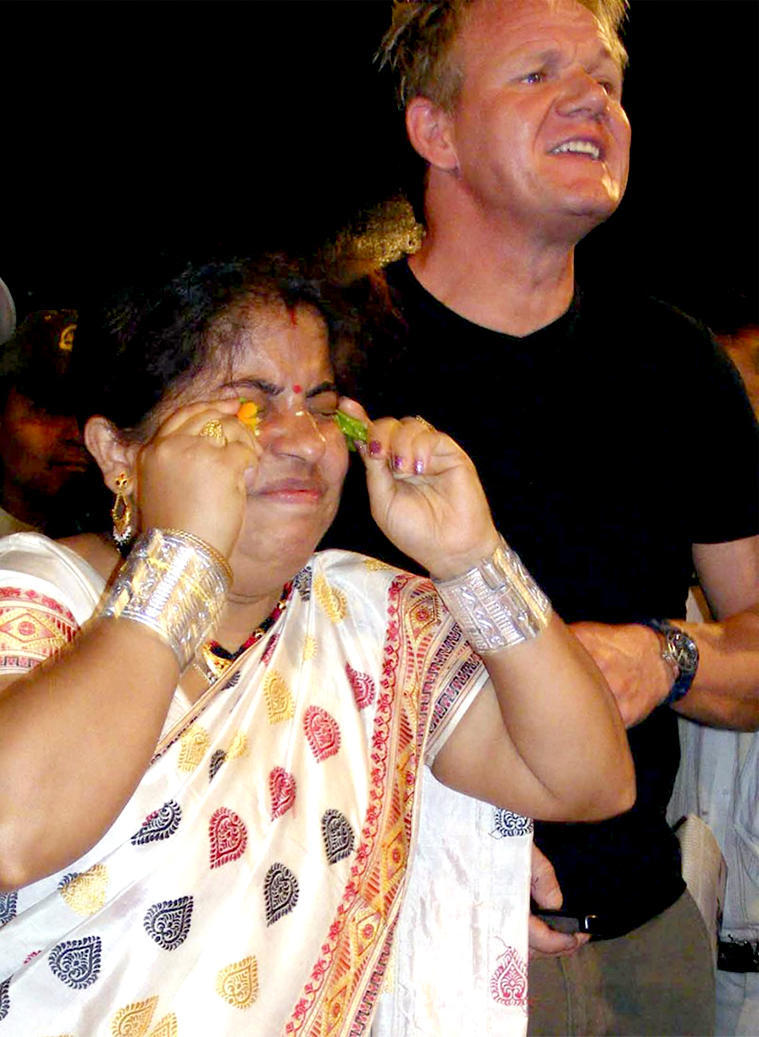
It was a tasty news morsel ten years ago: “Tezpur Chili hottest in the world.” Four Indian scientists had found a chili pepper in northeast India with a rating of 855,000 Scoville units — a forest fire of piquancy compared to the feeble flame of the nearest contender, the Mexican Red Savina habanero (a mere 577,000 Scoville units). The Scoville rating measures the presence of capsaicin, a compound that binds with pain receptors ordinarily triggered by heat and abrasion.
The news was delicious, and not just as a pick-me-up for a nation still hungry for global recognition. It seemed, oddly enough, like redress for a still-smarting historical wrong. For it was the colonial invasion of chili peppers — capsicum chilis from South America — that upstaged Indian black pepper (Piper nigrum), once the hottest commodity on the planet and the crown jewel of the spice trade.
We Indians had welcomed chilis graciously, of course. In time we became the world’s largest producers — and indeed, consumers — of what is technically a fruit. And now, at last, Indian nature and five hundred years of nurture had won out, in the form of a local cultivar, Capsicum frutescens var. Nagahari, aka Tezpur chili. The samples in question came from Tezpur, in the state of Assam (felicitously, Tezpur can be translated as “Spicyhot Town”), but the variety was better known locally by a variety of terms denoting fear and respect: Naga Jolokia (serpent chili),_ Bhut Jolokia (ghost chili) and _Bih Jolokia (poison chili) in Assamese, Raja Mirch (king pepper) in Hindi, Pasa Kala (chief chili) in Mishmi. At any rate, the research was published — a chili paper, as it were — in the Indian journal Current Science, along with diagrams showing the Tezpur chili’s capsaicin readings going off the charts.
These findings were met by consternation and disbelief, especially among the small but vociferous tribe of chiliheads, aficionados driven as much by masochistic machismo as by culinary concerns, most of whom reside in the United States and England. This strange new world of chili fanatics has fueled a multimillion-dollar hot sauce industry hawking products with names like Dave’s Ultimate Insanity Sauce, Blair’s Possible Side Effects, Rectal Rocket, and hundred-dollar bottles of pure capsaicin crystals capable of delivering sixteen million Scoville units. These were not the sort of people to just accept the idea that millions of people in a third-world country had been quietly besting them for generations, consuming the world’s hottest chilis more or less for free.
Skeptical chiliologists insinuated that the Indian research was flawed. They deplored the “constant nationalistic tone” of the scientists, who were, as it happens, working for India’s Defense Research Laboratories. Worst of all, they intimated that the Tezpur chili wasn’t Indian at all, just another variant of Capsicum chinense. (What don’t they make in China these days?)
Actually, Capsicum chinense is not Chinese. All chili pepper species derive from South or Central America; the term chili comes from the Nahuatl Chi-li. (Apparently the Aztecs had a glyph for it, too.) But the nomenclature of chiliology is littered with geographical confusions and nonsequiturs that go directly back to the origins of the New World — Columbus sailing west to find the Indies (and pepper) and stumbling upon the Americas (and chilis) instead. His first taste came in 1492, among the Taino. He enjoyed “ají, which is their pepper which is more valuable than black pepper, and all the people eat nothing else, it being very wholesome.” A hundred years later, the English herbalist John Gerard was still confused about the name: recommending the cultivation of chili plants in hot horse manure in his Herball or Generall Historie of Plantes, he calls it “Piper Indianum or Indicum or sometimes Piper Calicuthium or Piper Hispanicum… in low French Poivre d’Inde, very well known in the shops at Billingsgate by Ginnie Pepper, where it is usually bought.” Capsicum chinense, meanwhile, got its name from an eighteenth-century Dutch botanist, who thought the Caribbean chili seeds he was working with had come from China.
Peculiarly, although the European colonization of the world was driven in large part by the craze for Indian Indian pepper, until very recently the taste for chilis was largely reserved for the colonized, not the colonizer. And it should be said that not every use to which the colonized put the chili was excellent. The fruits of the capsicum family have certain innate punitive possibilities, as the Aztecs themselves recognized. A famous illustration in the sixteenth century Codex Mendoza depicts a father disciplining his son by holding him over a fire of smoking chili peppers. Here in India we took it a little further, as evinced in this enthusiastic passage from Science Reporter, an Indian popular science magazine, discussing the dangers of “capsaicin poisoning”:
Chili powder is often used by police in our country — and in fact in several third-world countries — to extract confession from criminals. It may be introduced in the mouth, nose, anus, urethra, or vagina to torture a suspect and extract confession from him. It is said that during emergency in India in 1976, chilies were used as a means of torture by introducing them in rectum! This process was known as Hyderabadi Goli… Finally, in our country, chili powder is often introduced in the vagina as a punishment for infidelity.
It’s true, by the way, about the Hyderabadi Goli. Back then our security forces believed the hottest chilis in the country came from Andhra Pradesh, the capital of which is Hyderabad. During Indira Gandhi’s twenty-one-month period of extraparliamentary rule, the Hyderabadi Goli was notoriously administered using a policeman’s cane slathered with mustard oil and chilis.
But Indian law enforcement has come a long way since then. In fact, the boffins at the Defense Research Laboratories had been researching ways to create a less lethal tear gas. (No less piquant, but literally less lethal — less likely to accidentally kill those exposed to it.) “Oleoresin capsicum (OC) is… environment-friendly and much safer,” they wrote. “Use of OC powders is growing and it is predicted to dominate the market in the coming years as the mainstay of riot control agents.”
Like latter-day Columbuses, they did not quite know what they had done. “Thus we have identified the hottest chili variety in India,” they concluded. When in fact, they had conquered the world.
It wasn’t until 2007 that the rest of the world finally admitted defeat. That February Guinness World Records certified that the hottest chili in the world was, in fact, the Naga Jolokia pepper, which the Indian scientists had called the Tezpur chili. Predictably, the Indian chili was only accepted in the West after it had been domesticated. An English gardener began selling seeds for what he called the “Dorset Naga,” and in 2006 one Paul Bosland, a scientist at the Chili Pepper Institute at New Mexico State University, took credit for discovering the Naga Jolokia’s potency. (Guinness World Records cites his research.) Nowadays, chiliheads are swilling bottles of American-made Naga hot sauce, including Dave’s Ghost Pepper Sauce, Blair’s Pure Death Sauce (with Jolokia), and Mad Dog 357 Ghost Pepper Sauce.
As you can probably tell, this burns me up a bit. I discovered the Naga Jolokia some twenty-five years ago on my first trip to the northeast, when I ordered a dish of egg curry and asked for extra chili. It was delicious, but within minutes my mouth and scalp were on fire. I experienced a dramatic bout of gustatory sweating and a temporary loss of hearing. I still remember it — and the jar of nougat candies that saved me. I have since acquired a taste for the chili, though I administer it with caution. I’ve learned the hard way not to touch my eyes and other tender parts after handling even uncut Naga Jolokias.

But there’s no point crying over spilled capsaicin. We’ve all moved on. India is still the world’s largest producer, consumer, and exporter of chili peppers, though in exports we’re beginning to feel the heat from — who else? — the Chinese. In 2009 the Indian Defense Research Development Organization announced the development of Naga Jolokia–based chili grenades for counter-insurgency operations. Meanwhile the Chili Pepper Institute’s latest genetic research has concluded that the Naga Jolokia is a “putative naturally occurring interspecific hybrid” of the chinense and frutescens. In England, another hothouse Frankenstein named Gerald Fowler has raised a bastard chili he calls the “Naga Viper,” which apparently has some 300,000 Scovilles on its Indian progenitor, and is slated for inclusion in the next Guinness World Records.
Back in Assam, a sweet-faced thirty-year-old housewife and mother named Anadita Dutta Tamuly took on celebrity British chef Gordon Ramsay in a special televised competition, consuming fifty-one Naga Jolokia chilis in just under two minutes. A weeping Ramsay left the field after a single bite, while Tamuly proceeded to rub the seeds of another twenty-five chilis in her eyes without shedding a tear. Ramsay volunteered to authenticate her achievement to the Guinness people, leading to anticipatory headlines cheering on the “world’s hottest woman.” I’m sure she’ll make India proud.